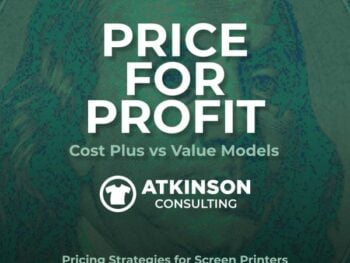“It doesn’t hurt enough.”
That was the punchline to one of Richard Greaves’ salient points from his Shirt Lab Ft. Worth presentation. This is in response to the question, “Why won’t you change?”
Indeed. Why won’t more people change what isn’t working?
The Old Guard Hurts Too
For some, the status quo, even though painful, isn’t as scary as the fear of doing something new. They know they need to change something but simply can’t because they fear the situation will worsen if the new version fails.
If anyone in your company (or even you) have muttered these words, “That’s the way we’ve always done it,” that is often grounded in fear.
This is why some long-in-the-tooth employees grumble like Yosemite Sam at the thought of trying something different. These are the people that embrace the itchy blanket of what is familiar, but often outdated or wrong, instead of even thinking of learning a different way to complete a task.
It doesn’t hurt enough. They are numb to the pain.
Fear by the way, is an acronym for “False Evidence Appearing Real.”
The Truth is Buried
Occassionally I’ll speak to someone in the industry that fully admits that they are struggling. As a business coach for the industry, I’ll listen to their tales of despair, and then I’ll ask a few questions.
“Have you tried this?” or “What about changing that?”
I get some sort of the same response. “I would change that if we could, but we just don’t have the time.”
That is when I show them that the consequences of non-action actually are using up more time and resources than they way they are doing things now.
My job, after all, is clarifying effective change.
Often, this is where digging in on metrics and data and illuminate how to solve particular challenges or situations in shops.
What Can You Change Right Now?
Those small, nagging pain points that you are experiencing now can often be resolved with a series of tiny improvements. You don’t have to have major overhauls to make a difference.
A lot of small, cumulative changes are what adds up to significant improvements. These can pay off in the long haul. What can you do in thirty minutes?
Start with the easy stuff. The low-handing fruit. The unbelievably obvious.
- Instead of looking at overhauling your entire shop’s operating software, check to see if every one is actually using it the same way.
- Clean tiny areas. 6′ x 6′. What can you straighten up, sort out, and shine up in about 15 minutes? Do that once a day.
- Look upstream in your process for problems. For example, ususally the reason why that job won’t register is found in the screen room craftsmanship, not on press.
- Assign people. Quite often the reason why something doesn’t get handled is that it isn’t somone’s responsibility.
- Learn. There are better ways to do pretty much everything. What are you implementing now?
- Ask more questions. Right now, why aren’t your printing or embroidering? Ask that every time you notice the machines aren’t decorating something.
- Talk to your people. Ask them what’s broken or what would make their jobs easier. They already know.
- Work to eliminate excuses. Anytime an excuse pops out, view that statement as an opportunity to change something.
Somewhere in your shop post a big whiteboard. On a consistent basis, record what hurts. Assign someone to tackle that challenge and add a due date.
Work the list.
“Work like you don’t need the money. Love like you’ve never been hurt. Dance like nobody is watching.” – Satchel Paige
“We are more often frightened than hurt; and we suffer more from imagination than reality.” – Lucious Anneous Seneca
“If you don’t deal with your demons, they will deal with you. And it’s gonna to hurt.” – Nikki Sixx
Help Support This Blog

If you like this blog and would like to support it, you can:
- Buy a book.
- Share this blog on your social media.
- Join Shirt Lab Tribe.
- Subscribe to the Success Stories podcast.
- Watch and like an episode on the Jerzees Adventures in Apparel Decorating YouTube series.
- Get signed up for the new Production Tracker app.
Also, my basic elevator pitch to you is I’m that help with “Clarifying effective change.” If you need help and want to learn more, please schedule a discovery call here.
Thanks!

Marshall Atkinson also shares exclusive blog content at Supacolor.com. Supacolor makes The World’s Best Heat Transfer and provides tips, inspiration, and other resources designed to empower professional garment printers.





1 comment